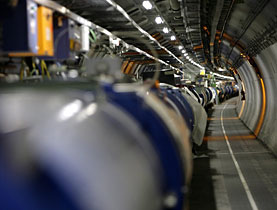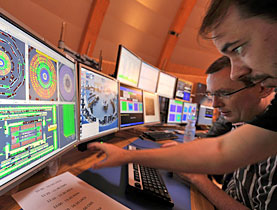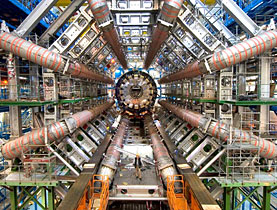Scientists in the cold as atom smasher thaws

It beams matter at close to the speed of light but it will take months before the world's largest particle accelerator returns to operation, scientists say.
Officials at the Geneva-based European Organization for Nuclear Research (Cern) said the Large Hadron Collider (LHC) would be out of business for two months or more after it suffered a technical problem on September 19.
Repairmen will not be able to work on the LHC until the device’s giant magnets have warmed up enough from a temperature of close to absolute zero – colder than deep outer space and far beyond the limits of what humans can withstand. This warming period alone is expected to last weeks.
On Monday, Cern’s spokesman refused to guess when the repair job on the most expensive and coldest science experiment in history might be completed.
“At the moment, the investigations are still ongoing and as soon as we are able to say anything concrete and factual, we will,” James Gillies told swissinfo. “Until then, we are not going to speculate.”
Gillies added the two-month timeline was a minimum; it included the warming and then re-cooling phase of the LHC – repairs not included. “We won’t know what the time scales will be until we’ve had a chance to get in and look and figure out what needs to be done,” he said.
Experts have already gone down into the 27-kilometre circular tunnel under the Swiss-French border to inspect the damage.
Glitches expected
Scientists expect start-up glitches in the massive, complex machines they use to smash atoms. The project took 20 years to complete at a cost of SFr6 billion ($5.46 billion). Scientists hope to replicate the conditions one trillionth of a second following the Big Bang 13 billion years ago.
But the unique qualities of the world’s largest particle collider meant that the meltdown of a small electrical connection could delay its groundbreaking research until next year, scientists said.
As a result, the equipment may not be running again before the planned shutdown of the equipment for the winter to reduce electricity costs. That means the meltdown could end up putting off high-energy collisions of particles – the machine’s ultimate objective – until 2009.
Superconducting
He said particle accelerators using superconducting equipment in the United States – at Fermilab outside Chicago and at Brookhaven National Laboratory in New York state – had similar problems starting up, but have been operating smoothly since then.
“Once they settled in they seem to be pretty stable,” Gillies said.
At the September 10 launch of the collider, beams of protons from the nuclei of atoms were fired first at close to the speed of light in a clockwise direction though a fire-hose-sized tube in the tunnel. Then proton beams were fired in the counter clockwise tube.
Jos Engelen, Cern’s chief scientific officer and deputy director-general, said the start-up showed that the LHC could handle complex operations.
“We have encountered a weakness in one particular connection during very final hardware commissioning,” Engelen said. “It is tough, but it can happen. We will make the repair and resume the very successful operation of the accelerator.”
A transformer failed outside the cold zone about 36 hours after the collider’s launch. That was repaired and the machine was ready again a week after it was shut down.
Proton shattering
But the goal of the LHC – shattering protons to reveal more about how the tiniest particles were first created – was still weeks away because the equipment has to be gradually brought to the higher energies possible at full power.
“This was the last circuit of the LHC to be tested at high current before operations,” Gillies said. “There are an awful lot of these connections between wires in the machine. They all have to be very well done so that they don’t stop superconducting, and what appears to have happened is that this connection stopped being superconducting.”
Superconductivity – the ability to conduct electricity without any resistance in some metals at low temperatures – allows for much greater efficiency in operating the electromagnets that guide the proton beams.
Without the superconducting, resistance builds up in the wires, causing them to overheat, he explained.
“That’s what we think happened,” Gillies said. “This piece of wire heated up, melted, and that led to a mechanical failure.”
Gillies said there is plenty for scientists at Cern to do between now and the start-up of experiments, including studying cosmic rays that pass through collider’s massive detectors.
swissinfo, Justin Häne with agencies
Cables for the LHC contain 6,300 “superconducting filaments of niobium-titanium” that are 0.006mm thick. In total, they stretch more than 10 times the Earth’s distance to the sun.
The LHC’s two proton beams will use as much energy as a 400-metric ton train travelling at 200 km/h.
The system’s magnet contains more iron than the Eiffel Tower.
Data recorded by the LRC will be enough to fill 100,000 DVDs each year.
In the LHC, high-energy protons in two counter-rotating beams are smashed together to search for exotic particles.
The beams contain billions of protons. Travelling just under the speed of light, they are guided by thousands of superconducting magnets.
The beams usually move through two vacuum pipes, but at four points they collide in the hearts of the main experiments, known by their acronyms: ALICE, ATLAS, CMS, and LHCb.
When operational, the detectors see up to 600 million collision events per second, with the experiments scouring the data for signs of extremely rare events such as the creation of the so-called God particle, the yet-to-be-discovered Higgs boson.

In compliance with the JTI standards
More: SWI swissinfo.ch certified by the Journalism Trust Initiative












You can find an overview of ongoing debates with our journalists here . Please join us!
If you want to start a conversation about a topic raised in this article or want to report factual errors, email us at english@swissinfo.ch.